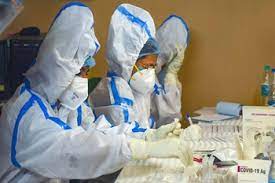
Human Metapneumovirus (HMPV) is a respiratory virus that has been steadily gaining attention globally, yet remains underrecognized in many countries, including Indonesia. While not as widely known as influenza or COVID-19, HMPV is a significant cause of respiratory infections, especially among vulnerable populations. The lack of widespread awareness about this virus in Indonesia presents a serious public health risk, making it crucial to raise awareness and take proactive steps to address this emerging threat.
What is HMPV?
HMPV is a member of the Paramyxoviridae family, which includes other respiratory viruses like respiratory syncytial virus (RSV) and parainfluenza. First identified in 2001, HMPV is primarily spread through respiratory droplets, which are released when an infected person coughs, sneezes, or talks. The virus can also spread by touching contaminated surfaces and then touching the face.
The symptoms of HMPV infection are similar to those of other respiratory illnesses, including:
- Fever
- Cough
- Nasal congestion
- Sore throat
- Shortness of breath
While many people recover without complications, HMPV can cause more severe illness, especially in infants, the elderly, and those with weakened immune systems. Severe cases can lead to bronchiolitis, pneumonia, or exacerbations of asthma and chronic obstructive pulmonary disease (COPD).
The Need for HMPV Awareness in Indonesia
Indonesia, with its large and diverse population, is highly susceptible to respiratory infections. Overcrowded urban areas, along with rural regions that lack adequate healthcare infrastructure, create an environment where respiratory viruses like HMPV can spread rapidly. The tropical climate further contributes to the transmission of respiratory diseases, making Indonesia particularly vulnerable during peak seasons.
One of the main challenges in addressing HMPV in Indonesia is the lack of awareness. Many people, including healthcare professionals, may not be familiar with the virus and its symptoms. As a result, cases of HMPV are often misdiagnosed as other respiratory illnesses, such as the flu or the common cold. This lack of recognition can delay treatment, leading to worse outcomes for patients.
The Importance of Public Health Campaigns
Raising awareness about HMPV is critical to reducing its impact in Indonesia. Public health campaigns can play a key role in educating the public about the virus, its symptoms, and how it spreads. By promoting good hygiene practices, such as regular handwashing, wearing masks, and covering coughs and sneezes, these campaigns can help prevent the spread of HMPV.
Schools, workplaces, and community centers should be targeted as venues for awareness efforts. These institutions can distribute educational materials, host workshops, and encourage healthy practices to reduce the transmission of respiratory viruses. Additionally, media outlets can be used to reach a broader audience and reinforce the importance of preventive measures.
Strengthening Healthcare Responses
Healthcare professionals must be equipped with the knowledge to recognize and diagnose HMPV accurately. Training programs should be implemented to help doctors, nurses, and other healthcare workers identify the symptoms of HMPV and differentiate it from other respiratory infections. Expanding access to diagnostic tests, such as polymerase chain reaction (PCR) tests, will allow for more accurate detection and timely treatment.
Furthermore, healthcare systems in Indonesia must be prepared for potential outbreaks. This includes ensuring that hospitals and clinics have the necessary resources, such as ventilators and oxygen therapy, to manage severe cases of HMPV.
Conclusion
HMPV is a growing public health concern in Indonesia, and raising awareness about the virus is an essential step in reducing its impact.